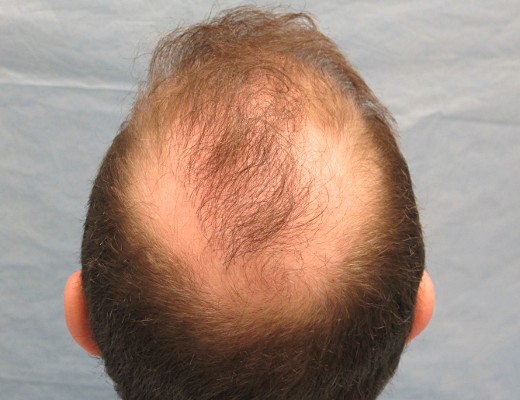Q: What is the problem with transplanting the crown too early? — P.L., Newark, NJ
A: If a person’s hair loss continues – which is almost always the case – the crown will expand and leave the transplanted area isolated, i.e. looking like a pony-tail. The surgeon can perform additional hair transplant procedures to re-connect the transplanted area to the fringe, but, as one can see from the photo below, this is a large area that can require a lot of hair. It is often impossible to determine when a person is young if the donor supply will be adequate. If there is not enough donor hair, then the island of hair may remain isolated. Most importantly, it uses up a lot of hair that might be better transplanted to the front and top of the scalp – areas that are far more important cosmetically.
The front and top of the scalp are more important to one’s appearance than the crown, and these areas should be the first priority when planning hair restoration surgery.
As an exception, if a person has a family history of baldness limited to the crown, even at an advanced age, and the person in question is following this pattern, then earlier treatment of the crown may be considered.
Lastly, if you do treat the crown in a younger person, or one with whom the extent of hair loss is uncertain, the crown should be transplanted with light coverage only. That way a limited amount of hair will be used up in this area and there will be enough left over for the more cosmetically significant top and front of the scalp.
For a complete review of this topic please read: Follicular Transplantation: Patient Evaluation and Surgical Planning. Dermatol Surg 1997; 23: 771-84. A copy in PDF format, and other hair transplant publications, can be downloaded at the Bernstein Medical – Center for Hair Restoration Medical Publications page.
View the Crown (Vertex) topic, the Age topic or see posts tagged with Early Hair Loss for further reading.
View Before and After Photos of some of our crown hair transplant patients
Read about candidacy for a hair transplant in young patients
Q: Can the crown be transplanted first instead of frontal area? Why is the crown the last choice? Any reasons behind it? — H.H., Ladue, M.I.
A: The crown can be transplanted first in patients who have very good donor reserves (i.e., high density and good scalp laxity). Otherwise, after a hair restoration procedure to the crown you may not be left with enough hair to complete the front and top if those areas were to bald.
Cosmetically, the front and top are much more important to restore than the back. A careful examination by a trained hair restoration surgeon can tell how much donor hair there is available for a hair transplant.
For more information on this topic, see my publication on surgical planning of hair transplants, “Follicular Transplantation: Patient Evaluation and Surgical Planning.”
Q: I had my second hair restoration procedure nearly 5 months back. New hair in the front part of the head is growing well, but the crown is growing slow. Is this common? Also does the new hair grow more slowly after second hair transplant procedure? — B.V., Richmond, U.K.
A: Yes, it is typical for hair in the crown to grow more slowly than the front and top of the scalp and the second procedure generally grows more slowly than the first.
Q: Should you perform a hair transplant on a crown that is just starting to thin? — R.R. Philadelphia, Pennsylvania
A: A “thin” crown should first be treated with Propecia, as it may thicken the hair to a cosmetically acceptable degree without the need for surgery. If Propecia is ineffective in restoring enough hair, then surgical hair restoration can be considered.
The surgeon must also factor whether or not the patient has enough donor reserves to transplant the front and top part of the scalp if the patient becomes very bald. This is hard to predict in patients who are still in their twenties.
See the paper Follicular Transplantation: Patient Evaluation and Surgical Planning for a more complete discussion.
Browse Hair Restoration Answers by topic:






